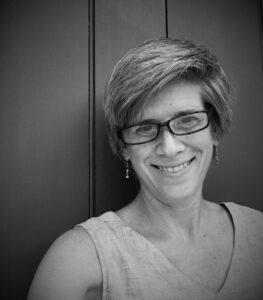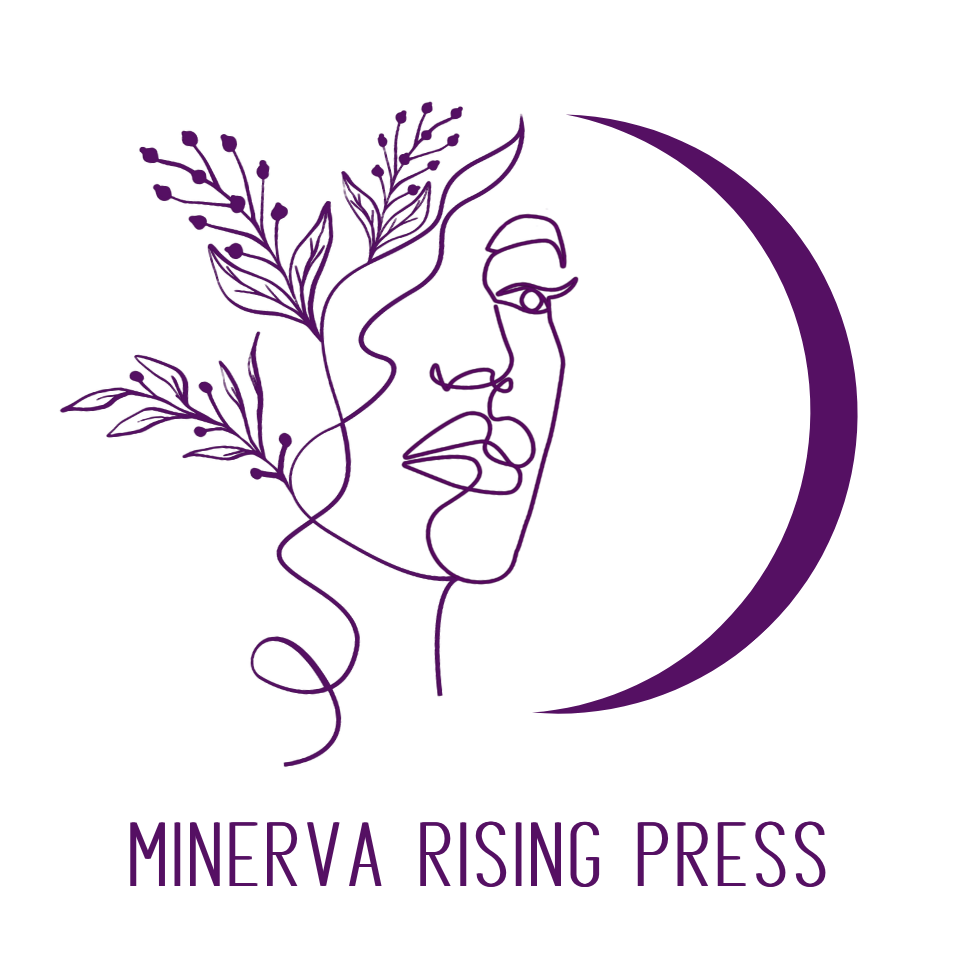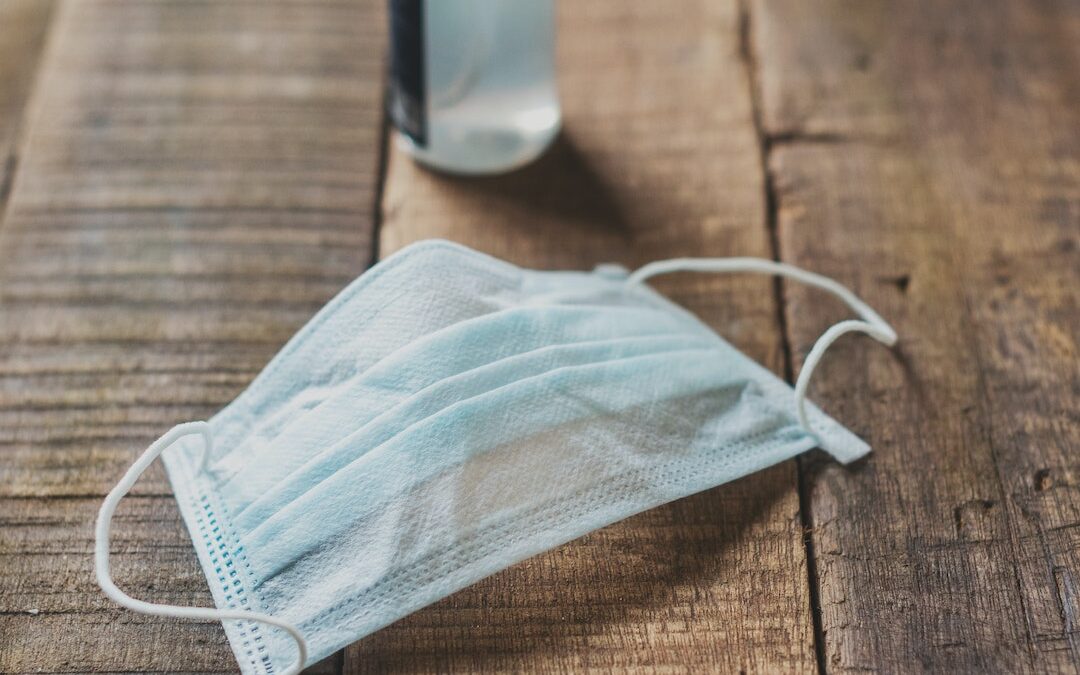Today I am recalling January, thumbing through my day planner, trying to pin this down, trying to put brackets around it.
On Monday, January 27, I fly from Portland, Maine to Pittsburgh to visit family. The trip requires two flights, and I wear a mask in both planes. In one of the airports and on one of my flights, I see two different men also wearing masks, and I am grateful for the momentary locking of our eyes, our mouths inscrutable.
Three days later, I return from Pittsburgh. Again, masked. This time, though, I am alone. I feel a little self-conscious, but not enough to alter my behavior. A defiant masker has already been born.
I got the mask at a doctor’s appointment on Wednesday, January 8. It was a follow-up for blood pressure. As I approached the check-in counter, my eye caught the station set up with sanitizer and a box of masks — Take one if you’re coughing, sneezing, or have a fever. I slipped one in my pocket and pumped sanitizer into my palm. Because why not?
♦
I share this not to show how clever or prescient I was, but how a circuit breaker of anxiety had already tripped. On the morning of that doctor’s appointment, I had read a story in The New York Times that puzzled over a strange, pneumonia-like illness in Wuhan, China.[i] There was no evidence that it was spreading from person-to-person, the story said, and more research was necessary, but it then proceeded to note that people from Hong Kong and South Korea, who had recently been to Wuhan, seemed to be coming down with the same symptoms. In an instant, my non-scientific mind envisioned this virus indeed hopping on other people who were boarding planes and dispersing around the world. Severe acute respiratory syndrome was mentioned: “SARS, a respiratory disease and also a coronavirus, spread from southern China in 2003 and infected more than 3,000 people, killing 774.”[ii]
Those numbers were meant to sound alarm bells, but I only vaguely remember hearing about SARS back then. What was I even doing in 2003? Driving my sons here and there. Writing short stories. Coaching a high school girls’ basketball team. Fretting and fuming over Bush and Cheney and Rumsfeld and wars for oil. SARS was some far-away virus that had nothing to do with me. In January 2020, though, a couple of news articles untether my propensity to “what if?” What if there is a virus from the other side of the world already floating in the air in Maine, in Pennsylvania? What if it’s already here?
These are the starting points for this particular strain of anxiety that I have been trying to contain for more than six months now, but it is mutating all the time.
♦
I can do no writing in the room in my house formerly known as “my office.” It’s really a charming room, with sloped ceilings and two low windows that look out onto a pool and some lovely flower beds that riot with Black-eyed Susans in summer, all courtesy of the former owners. Maybe it’s the piles of papers and books from teaching from the year before, gun violence prevention materials, research and drafts for the never-ending memoir-in-progress, the taxes, the junk mail, the unread magazines. I can’t think in there anymore, can’t finish my book with the ceiling the way it is, closing in on me.
♦
Early in March, when it starts to become clear that COVID-19 is, indeed, here, and I come to think of the nice people in the coffee shop, where I’ve been writing for the last two months, as possible disease vectors. I de-camp to the room in the house that my partner calls “The Library” because for the longest time it had the only built-in bookshelf in the house. I insist on calling it “The Living Room,” one of those rooms where some people, including us, put the good furniture that no one ever uses. We have another room with another sofa that he calls the “The Florida Room” because it has a tile floor and a high ceiling and a ceiling fan and lots of windows, which is where we watch TV and nap and keep the houseplants, but which I call “The Family Room,” only it’s usually just the two of us. My family is far away, and now I don’t know if or when I’ll ever see them again. My mother. My sons. My brothers and sisters and their families. And all my dear ones back in New Jersey and Pennsylvania, and a lot of other places, now that I think about it. And this is not hyperbole—that I may never see them again. That’s the virus talking.
♦
The Library Living Room, where I work, has a normal-height ceiling and four normal-sized windows. When I sit at the very simple table in there with my laptop, I can look out two of the windows onto our side yard on land once inhabited and cared for by the Abenaki people. I see a couple of apple trees, and cardinals and blue jays flitting this way and that at a nearby feeder. Sometimes wild turkeys strut by, a succession of lone couples out foraging together, the gobblers larger than the hens. They’re all pretty skittish, bobbing and pecking in a stream of nervous tics, it seems to me, even though they have no idea what’s going on in Italy and New York City, and I bet they’re all going to make it to the other side of this. Then again, they’re always on the lookout for predators. Still, I briefly envy them: they don’t know about COVID-19.
♦
I gravitate toward reading articles on my phone, reaching for it as soon as I awaken in the mornings, and my heart starts to race. I buy books to support local bookstores, but after they are delivered and spend time on the Decontamination Bench in the garage for a couple days, I move them to the growing piles crowding the floor next to my bed, half-started, half-finished. What’s the difference? No, really. What’s the difference?
♦
I start a blog. “Welcome to my COVID-19 Chronicle, where I try to remain balanced physically, emotionally, mentally, and spiritually through this crisis… I hope this journal will provide another bit of human connection, wherever you may be on this fragile planet of ours at this particular moment in time.”
The first posts appear on… let me go back and look that up… March 16. No posts appear after April 1. Apparently, I can’t keep up the positive patter for more than a couple weeks. Look at what I baked! Look at the Mother Nature I saw today! I lose track of time. There’s a sameness to the days, the house, and the walks, encountering neighbors I’ve never seen before, the tentative hellos, then the curl back into my head.
♦
I get into the habit of checking the pantry closet, and the bench near the dining table where I now keep cans of beans and tuna. Canned goods remind me of my childhood when we always had a solid stash of green beans, corn, and peas. As an adult, I much prefer frozen vegetables when the fresh run out. Now I like to open the spare refrigerator in the garage and see the yogurts and cartons of oat milk lined up. In the early days of the lockdown, we stocked up on cauliflower, carrots, and Brussel sprouts—root vegetables that would keep. I like to keep tabs on our dwindling supplies, even as fear of deprivation creeps in. What if he or I got sick today? Would the other have enough of this or that to see them through? At first, our groceries last for three weeks. Then on the next trip, I say, “Let’s get enough for four!” I consider it a sort of dry run for the apocalypse. Only it’s not a dry run.
♦
When fear and urgency compel me, I buy from the Evil Empire—sanitizer, face masks, gloves, thermometers, pulse oximeters, face shields. I ship various supplies to my mother, my sons, until one of them says, “Stop.”
♦
As spring limps into view, I order three yards of mulch. Since we moved here five years ago, I have taken on the responsibility of not letting the prior owner’s unbelievable flower gardens be destroyed by my incompetence or laziness. Of course, I love to look at the successive blooming of all kinds of iris, daisies, phlox, sunflowers, and many other species I still can’t name, but I remain an unenthusiastic flower gardener. Except this year, I will re-etch the border around the beds out front to give them that finished, professional look. Whenever I need a break from writing or from the news, there is always a pile of mulch, a shovel, and a wheelbarrow waiting for me on those mostly raw days. I realize this is a privilege. All I have to do is keep myself and the mulch moving from the driveway to the beds. And when that first pile is gone, I order another. I realize that keeping up appearances is all about the illusion of control. I move the mulch anyway.
♦
At some point in April, I have to stop reading every article about this virus. There are a lot of numbers being bandied about for every delineated, populated region on the planet: cases, positives, presumptive positives, ventilators, ICU beds, deaths, and the bodies, devastation, and sorrow piling up. We can no longer properly count, no longer properly gather to put a prayer around the end of a life, no longer contain any of it.
♦
It seems COVID-19 is everywhere. Except if you’re one of those people who thinks it isn’t.
♦
You gotta love the armed white men, flocking to state houses across the United States, protesting governmental orders to wear masks, all bunched together on the steps like lost children in a deep, dark wood, holding signs that say, “My body, my choice.” They have no idea how hilarious they are. They probably haven’t read the articles about the crystalized lung tissue in COVID patients who aren’t going to make it. It looks like glass. Or maybe snowflakes.
On second thought, you don’t have to love them.
♦
I find myself unusually concerned with what I cannot see: How to set up a border between my nasal passages, mouth, and eyes and you and your droplets—some universal “you” and “your.” Those first few trips to the grocery store I gear up, strategize, plan how I will move swiftly through my list and through the store. I don’t see the other customers as people. They are obstacles, Purveyors of Respiratory Droplets, to be given wide berth, or avoided completely, if I can come at the bran flakes from the other end. This is before stores start herding us with painted arrows on the floors when it is still a kind of Wild West, and the sheriffs among us are sheathed in gloves, masks, and the moral rectitude that we think disguises the fear that makes us twitchy, snappish. What are you looking at, you—you—Unmasked Breather?
♦
My partner has two N95 masks in his woodworking shop—one for him, one for me. At first, this is what I use to go grocery shopping, and I treat it with reverence because I am re-using it. Later, when some of the cheaper surgical masks become available again, I use those with a cloth mask on top, preserving the N95. For when things get really bad. Because it’s going to get bad again before there’s a vaccine. That’s what Dr. Fauci and Dr. Gupta and all the real doctors say on TV and all the real epidemiologists in all the real articles.
I know that the whole point of a mask is for the wearer to protect those around her by containing her own droplets. But I can’t stop myself from feeling that I am also protecting myself, even after I read the article about how well each type of mask and the various types of material stop—or don’t stop—the spread of various-sized droplets. Nothing works 100%. That’s when I order the plastic face shields. There doesn’t seem to be a shortage of them now, but you just wait ‘til October. I haven’t used them yet, though. I’m not that far gone.
♦
I can do no writing on the days we shop for groceries, wash the groceries, put away the groceries. I must lie down afterward in The Florida Family Room with Andrew Cuomo murmuring reassurances on low. Are my friends in New York okay today? I need to call my mom when I wake up.
♦
In May, I allow myself cautious entry at home improvement stores and gardening centers, weaving around people like the point guard I used to be. Vegetable gardening is one of my hobbies. Well, no, it might be my only hobby, besides worrying. I really need to get more healthy hobbies. I tried to start to learn French—what month was that? I did yoga twice. The ukulele I got for Christmas sits, untouched, in the room where I write, on the sofa where no one sits.
In the hardware store, I look for protective eyewear, for when I use the weed whacker. And I remember about the droplets and pick up a pair of goggles and also a pair of safety glasses that look like the very sporty sunglasses of a mountain biker or marathoner, someone unbound and healthy and free. Only the lenses of the safety glasses are clear, very clear. I pretend I can see the world as it really is.
♦
I watch George Floyd’s murder exactly once.
♦
A Black man’s life for $20.
♦
Dear White People: When are we going to put our bodies in between?
♦
I read and read and read—which seems to be the initial inclination of White people no matter where they are in their waking up. I scroll and scroll and scroll and post on Facebook and check in with some of my Black and Brown friends. I make a sign and go to exactly one Black Lives Matter protest, standing around the edges, chanting into my mask, taking pictures, and cheering on the marchers. I want to be shoulder-to-shoulder with them. But I am afraid, not just of COVID but of my own body, the way it has reacted to another virus over the years, the fatigue and sore throats and the pneumonia and other infections that have followed. I feel vulnerable, old, and useless in the face of all the work that needs to be done in the streets. I want to be with the people. I want to fucking scream until I am hoarse. Instead, I turn off the TV, take my blood pressure pill, donate, sign petitions, re-post news from credible sources and people on the ground, speak up in my circles of privilege, and continue my gun violence prevention advocacy. These I can do.
♦
On July 29, 2020 at 10:19 a.m. EDT, according to the Johns Hopkins COVID-19 dashboard, there have been 661,203 deaths worldwide. The United States accounts for 149,375 of them. [iii]
India has about 1.35 billion people and 1.5 million cases. We have .328 billion people and 4.36 million cases.[iv]
By the time I finish writing this, the U.S. has surpassed 150,000 deaths.[v]
♦
At Maine.gov, under Phase 2: Large Social Gatherings, it says: “Projection of respiratory particles is increased during singing, yelling, dancing, sports, and games. Exposure to respiratory droplets with such activities increases the transmission risk of COVID-19 to attendees, particularly in crowded areas and indoor settings.”[vi] I can’t imagine actually doing any of this, even though my thoughts themselves sing and yell and dance, and they are crowded, very crowded, in my head. I wish they would be very still for a very long time. Or at least as long as it takes.
♦
After a lull, the turkeys are back, only they have multiplied, fanning out and re-grouping. Their many poults scurry to keep up with the haphazard parade across our parched lawn, together in the ways wild turkeys have always been together, in what is apparently known as a rafter. I miss my poults. And I miss my rafters, all the various incarnations of them, spread across this feverish, throbbing country. Maybe next year—surely the year after—we’ll jostle and hug and tell open-mouthed stories over tables laden with food in the way that humans do, if we can just hang on.
______________
[1] Sui-Lee Wee and Donald G. McNeil Jr., “China Identifies New Virus Causing Pneumonialike Illness,” The New York Times, January 8, 2020, updated January 21, 2020, https://www.nytimes.com/2020/01/08/health/china-pneumonia-outbreak-virus.html?searchResultPosition=181 (accessed July 29, 2020).
[1] Wee and McNeil, Jr., “China Identifies New Virus Causing Pneumonialike Illness,” The New York Times, January 8, 2020, updated January 21, 2020, (accessed July 29, 2020).
[1] https://coronavirus.jhu.edu/map.html. Accessed July 29, 2020.
[1] https://coronavirus.jhu.edu/map.html. Accessed July 29, 2020.
[1] https://coronavirus.jhu.edu/map.html. Accessed July 30, 2020.
[1] https://www.maine.gov/decd/checklists/large-social-gatherings. Under “COVID19 Prevention Checklist Industry Guidance.” Updated July 24, 2020. Accessed July 30, 2020.
 Sue Repko was the 2019 Maine Literary Award winner for short nonfiction. Her work has been named notable in The Best American Essays three times and has appeared in Hazlitt, The Southeast Review, The Common, Hippocampus, and elsewhere. She teaches at Phillips Exeter Academy and is completing a memoir.
Sue Repko was the 2019 Maine Literary Award winner for short nonfiction. Her work has been named notable in The Best American Essays three times and has appeared in Hazlitt, The Southeast Review, The Common, Hippocampus, and elsewhere. She teaches at Phillips Exeter Academy and is completing a memoir.


